#03: Mercury Planetary Orbiter takes a simulated trip to the innermost planet
12 October 2011
Thermal-balance testing of the BepiColombo Mercury Planetary Orbiter Structural and Thermal Model, which has been under way in ESA's Large Space Simulator since 20 September, has been successfully completed. During these tests the conditions the spacecraft will encounter during the cruise to Mercury and while in orbit have been simulated, and a number of tests to characterise the spacecraft performance under some worst-case scenarios have been carried out.'Dry run' in the Large Space Simulator
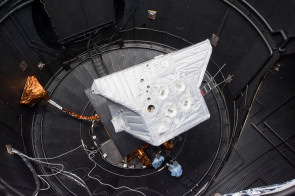 |
|
The MPO inside the LSS, prepared for its 'dry run' on 13 September. |
Following the installation of the Mercury Planetary Orbiter (MPO) Structural and Thermal Model (STM) in the Large Space Simulator (LSS) at ESA's Test Centre in Noordwijk, the Netherlands on 31 August and the completion of all the necessary preparations, a 'dry run' was conducted on 13 September to verify the performance of the spacecraft, its instrumentation, and the gimbal stand / spin box and levelling table that support, orient, rotate and level the spacecraft during testing.
The dry run was performed with the LSS top cover open; the MPO was illuminated with just one of the nineteen 25-kW lamps that make up the solar simulator. In order to reach the radiation intensity that the orbiter will experience in orbit around Mercury, the 121 hexagonal mirror segments that produce the beam have been adjusted to produce a converging beam rather than the standard parallel beam. To allow the wall of the LSS to cope with the increased beam intensity while continuing to simulate the cold of space, an additional shroud has been installed.
Pump down and cold calibration
After the dry run, the LSS top hatch was closed and vacuum pumping commenced on 20 September. Once a vacuum of around 10-5 mbar had been achieved, liquid nitrogen started to be pumped through the shrouds of the chamber walls to cool the interior of the LSS down to less than -173 °C (100 K). Once cool-down was completed, the steady state under cold conditions (referred to as 'cold calibration') was achieved and baseline data were acquired.
Cruise and orbit
On 22 September, simulation of the initial cruise phase of MPO's journey to Mercury began. This was followed, the next day, by the intermediate cruise phase; testing under in-orbit conditions followed, beginning on 26 September with conditions at aphelion and then moving on to perihelion. Particular attention has been paid to conditions at perihelion, where the MPO will be most strongly illuminated.
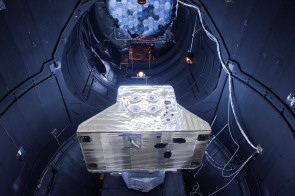 |
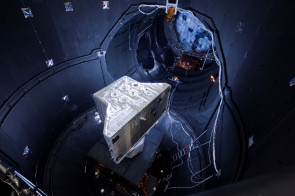 |
|
The MPO inside the LSS, ready for its 'dry run' on 13 September. |
|
Investigations of the spacecraft's thermal performance during entry into and exit from eclipse have also been also carried out through 'snapshots' at various attitudes (for example, rotation of 45 degrees with the Sun on the +Y/-X faces and tilting of 30 degrees with the Sun on the +Z/+Y faces).
Around 4000 litres of liquid nitrogen are consumed per hour during testing, so a steady stream of tankers have been arriving to replenish the 100 000-litre on-site storage capacity.
The heaters that simulate the thermal dissipation of the electronics units and those that warm critical components during eclipse are powered by external power sources during testing. Temperature data, obtained using thermocouples, are acquired by the thermal data handling system that is part of the LSS.
Two infrared cameras are used to monitor the spacecraft's multi-layer insulation and items external to the satellite that face the Sun simulator.
To maintain realistic conditions for the heat pipe network, which is designed to work in the microgravity of Mercury orbit, the satellite is kept levelled by adjusting the levelling table and acquiring readings from on-board tilt meters.
Non-nominal attitude - testing the worst-case scenario
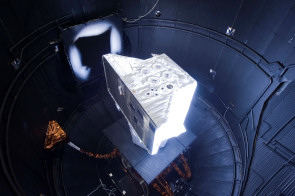 |
|
The MPO inside the LSS during the 'dry run' on 13 September. Credit: ESA/Anneke Le'Floch |
In addition to simulating the nominal case, a series of tests have been carried out to investigate the thermal behaviour of the MPO in the event that its nominal attitude in orbit is temporarily lost. Loss of attitude might result in parts of the spacecraft that are not intended to be exposed to intense solar radiation being illuminated until its nominal attitude can be restored. These tests will demonstrate that the spacecraft structure and thermal control systems can withstand such unintended exposure.
Two particular cases of 'loss of attitude' were replicated: in the first scenario the situation where a loss of attitude results in the Sun being orthogonal to the MPO radiator was simulated by rotating the spacecraft so that the radiator was directly exposed to sunlight for 10 seconds, and then rotating the spacecraft back to its original position - to simulate the restoration of attitude control.
The second scenario simulated a loss of attitude that results in sunlight directly passing through the louvres onto the radiator. For this test the Sun was temporarily switched off - by closing the shutters on the Sun simulator - the spacecraft was rotated so that the radiator was in front of the Sun simulator and then tilted by 30 degrees towards the large 5-metre door on the LSS, in other words, facing away from the Sun so that when the shutter was opened sunlight passed through the louvres onto the radiator. After 50 seconds of exposure the shutter was closed, simulating the spacecraft return to nominal attitude.
Warm up and pressure recovery
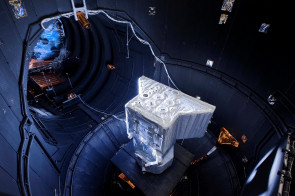 |
|
The MPO inside the LSS during the 'dry run' on 13 September. Credit: ESA/Anneke Le'Floch |
With the completion of the thermal-balance tests on 6 October, cooling of the LSS was gradually reduced and the satellite and chamber were allowed to return to ambient temperature; this took about 1.5 days. On 8 October, once the warm up was complete, the vacuum pumps were stopped and the pressure was restored to normal atmospheric levels using gaseous nitrogen and air over the course of about 8 hours. The MPO STM will soon be removed from the LSS and preparations will begin for the next phase of testing.
Next stages
A number of deployable appendages and antennas will be installed on the MPO and deployment shock tests will be performed. The physical properties of the spacecraft - mass, centre of gravity, moment of inertia about all three axes - will be measured to confirm that they match the design values. The MPO will then be ready for integration into the Mercury Composite Spacecraft (MCS) - the configuration in which the MPO, the Mercury Magnetospheric Orbiter (MMO), the Mercury Transfer Module (MTM) and the Magnetospheric Orbiter Sunshade and Interface (MOSIF) will be launched and travel to Mercury. The next phase of testing will include mechanical and acoustic testing of the MCS to qualify the structures for the dynamic mechanical environment specified by the launcher authority.
About BepiColombo
BepiColombo is Europe's first mission to Mercury. It is scheduled to launch in August 2015 and arrive at Mercury in January 2022. It will endure temperatures in excess of 350 °C and gather data during a one-year nominal mission, with a possible one-year extension. The mission comprises two spacecraft: the Mercury Planetary Orbiter (MPO) and the Mercury Magnetospheric Orbiter (MMO). During the journey to Mercury, the MMO will be shielded from the Sun by the Magnetospheric Orbiter Sunshield and Interface Structure (MOSIF), which also provides the interface between the MMO and the MPO. The fourth component of the composite spacecraft stack is the Mercury Transfer Module (MTM), whose primary task is to provide solar-electric propulsion for the journey to Mercury.
BepiColombo is a joint mission by ESA and the Japan Aerospace Exploration Agency (JAXA), executed under ESA leadership. The Prime Contractor for BepiColombo is Astrium GmbH.





